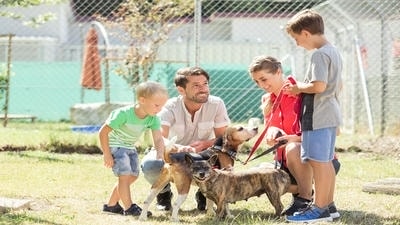
Pet adoption is a meaningful and compassionate way to bring a new furry friend into your family. While many families consider purchasing pets from breeders or pet stores, adopting a rescue pet offers unique benefits that go beyond companionship. Not only do rescue pets provide unconditional love, but they also teach children valuable lessons about empathy, responsibility, and the importance of giving animals a second chance.
Every year, millions of animals end up in shelters, waiting for a loving home. By choosing to adopt a rescue pet, you’re not only saving a life but also making a positive impact on the animal welfare community. Teaching kids about pet adoption helps them understand the importance of compassion, responsibility, and the value of giving animals a second chance. Here’s why adoption matters:

Rescue pets are not only deserving of love and care, but they also bring unique qualities to a family. Here are some reasons why rescue pets make great additions to households with children:
Many rescue pets have faced challenges in their lives, such as abandonment, abuse, or neglect. Despite their past, these animals often show incredible resilience and adaptability, quickly forming strong bonds with their new families.
Rescue pets often display a deep sense of gratitude and loyalty to their adoptive families. They seem to understand that they’ve been given a second chance, and they repay that kindness with unconditional love and devotion.
Many rescue pets have already been trained and socialized by their previous owners or shelter staff. This can make the transition into your home smoother, especially for families with young children.
Rescue pets come in all shapes, sizes, and personalities. Whether you’re looking for a playful dog, a cuddly cat, or a laid-back rabbit, shelters have a wide variety of animals to choose from.
Adopting a rescue pet teaches children the importance of compassion and second chances. It’s an opportunity to show kids that everyone deserves love and care, regardless of their past.
Educating children about pet adoption is an important step in fostering a sense of responsibility and empathy. Here’s how to approach the topic and involve your kids in the adoption process:
Begin by explaining what pet adoption means and why it’s important. Use age-appropriate language to discuss the challenges faced by animals in shelters and the benefits of giving them a loving home.
Take your children to visit a local animal shelter or rescue organization. Let them interact with the animals and learn about their stories. This firsthand experience can help kids understand the impact of adoption.
Involve your children in the adoption process by letting them help choose the pet, prepare the home, and participate in care routines. This involvement helps them feel connected and responsible.
Share stories of rescue pets who have found loving homes and thrived in their new environments. These stories can inspire children and reinforce the importance of adoption.
Set a positive example by treating your rescue pet with kindness, patience, and respect. Show your children how to care for their new furry friend and demonstrate the rewards of giving an animal a second chance.

Adopting a rescue pet involves several steps to ensure that the animal is a good fit for your family. Here’s what to expect during the adoption process:
Start by researching different shelters and rescues in your area. Consider your family’s lifestyle, preferences, and needs when selecting the type of pet to adopt. Prepare your home by gathering supplies and creating a safe space for the new pet.
Visit the shelter or rescue organization to meet the animals in person. Spend time interacting with them to get a sense of their personality and compatibility with your family.
Most shelters require an adoption application and screening process. This may include questions about your living situation, experience with pets, and ability to care for the animal.
If possible, arrange a meet and greet between the pet and your family to ensure compatibility. This is especially important for families with young children or other pets.
Once approved, you’ll pay an adoption fee and complete the necessary paperwork. Adoption fees typically cover medical expenses, vaccinations, and spaying or neutering.
After the adoption is finalized, prepare to bring your new pet home. Be patient during the transition period, as it may take time for the pet to adjust to their new environment.
Bringing a rescue pet into your home is an exciting time, but it’s important to be patient and understanding as they adjust. Here are some tips to help your new pet settle in:
Set up a designated area for your pet that includes their bed, food and water bowls, and toys. This space should be quiet and comfortable, allowing them to retreat when needed.
Maintain a consistent routine for feeding, exercise, and playtime to help your pet feel secure and establish a sense of normalcy.
Rescue pets may need time to adjust to their new environment and build trust with their new family. Be patient and give them space to explore and feel comfortable.
Use positive reinforcement, such as treats, praise, and affection, to encourage good behavior and build a strong bond with your pet.
If your rescue pet shows signs of anxiety, fear, or behavioral issues, consider seeking help from a veterinarian or animal behaviorist.

Involving kids in the care of their rescue pet teaches them responsibility and empathy. Here’s how to engage your children in pet care:
Give your children age-appropriate responsibilities, such as filling the food and water bowls, brushing the pet’s fur, or helping with playtime.
Educate your children on how to interact with their pet gently and respectfully. Encourage them to avoid rough handling or loud noises that may scare the pet.
Teach your children to recognize their pet’s needs, such as hunger, thirst, or the need for a bathroom break. This helps them develop empathy and understanding.
Acknowledge and celebrate milestones, such as the pet’s first week at home or successful training sessions. This reinforces positive behavior and encourages responsible pet ownership.
Encourage your children to spend quality time with their pet through play, cuddling, or training. These activities strengthen the bond between kids and their furry friend.
Adopting a rescue pet has long-term benefits for both your family and the animal. Here’s how it positively impacts everyone involved:
Teaching kids about pet adoption is a powerful way to instill values of compassion, empathy, and responsibility. Rescue pets make wonderful family members, offering unconditional love and teaching important life lessons. By involving your children in the adoption process and encouraging them to care for their new furry friend, you can create a lasting bond and make a positive impact on the lives of both your family and the animal. So, consider opening your heart and home to a rescue pet, and experience the joy and fulfillment that comes with giving an animal a second chance.